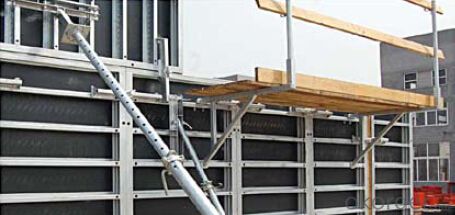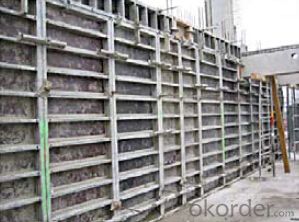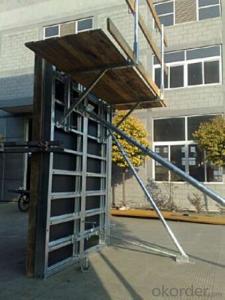Steel-frame formwork platform
- Loading Port:
- China Main Port
- Payment Terms:
- TT OR LC
- Min Order Qty:
- -
- Supply Capability:
- -
OKorder Service Pledge
OKorder Financial Service
You Might Also Like
Steel-frame Formwork SF-140
Characteristics:
◆ Few parts for fast forming.
◆ Max. Concrete pressure: 80KN/m2.
◆ Hot-dip galvanized steel frame.
◆ The thickness of plywood is 18mm & the panel is 14cm.
◆ Compatibility with Hunnebeck Manto system due to similar edge profile.
System Details & Application:
◆ Neat joint and fast assembling with aligning panel clamp.
◆ Flexible panel arrangement and height extension.
◆ The selection of panels.
◆ Kinds of panel connectors.
◆ Corner clamp application.
◆ Length adjustment application.
◆ Height adjustment & aligning strut.
◆ Walkway bracket & platform.




- Q:Can steel formwork be used for high-rise construction projects?
- Yes, steel formwork can be used for high-rise construction projects. Steel formwork is known for its strength and durability, making it suitable for heavy-duty applications such as high-rise construction. It provides excellent stability and support to the concrete during the pouring and curing process, ensuring the structural integrity of the building. Additionally, steel formwork can be easily assembled and disassembled, making it efficient for use in tall structures where multiple floors need to be constructed. Its reusable nature also allows for cost savings in the long run. Overall, steel formwork is a reliable and popular choice for high-rise construction projects.
- Q:How does steel formwork handle vibrations from construction equipment?
- Steel formwork is known for its excellent strength and durability, which enables it to effectively handle vibrations from construction equipment. The rigid nature of steel formwork allows it to withstand the impact and oscillations caused by heavy machinery or equipment without significant deformation or damage. Additionally, the structural stability and stiffness of steel formwork help to minimize any unwanted movement or shaking during construction activities, ensuring a stable and reliable foundation for the construction process.
- Q:How does steel formwork contribute to the overall structural integrity of the building?
- Steel formwork contributes to the overall structural integrity of the building by providing a strong and durable framework for concrete construction. It ensures accurate and precise alignment of walls, columns, and beams, resulting in a structurally sound and stable building. The steel formwork system is capable of withstanding heavy loads and forces during construction and enhances the overall strength and stability of the structure. Additionally, the use of steel formwork allows for easy and efficient construction, reducing construction time and costs while ensuring high-quality and long-lasting buildings.
- Q:What are the considerations when designing steel formwork for swimming pools?
- Several important factors must be considered when designing steel formwork for swimming pools. These factors include the structural integrity and strength of the formwork, the accuracy and precision of its dimensions, the ease of assembly and disassembly, and its ability to withstand the corrosive effects of water and pool chemicals. To begin with, the structural integrity and strength of the steel formwork are of utmost importance. It must be capable of supporting the weight and pressure exerted by the concrete during pouring and curing. The design should prevent any potential deformation or buckling that could compromise the pool structure. The thickness and reinforcement of the steel must be calculated meticulously to meet the required load-bearing capacity. The accuracy and precision of the formwork's dimensions are also crucial considerations. The design should ensure precise and consistent dimensions to maintain the pool's shape and size accurately. This is particularly critical for swimming pools, as any deviation from the intended design could lead to uneven water levels or compromised aesthetic appeal. Another consideration is the ease of assembly and disassembly. The formwork should be designed for effortless installation and removal to facilitate efficient construction processes. The components should securely fit together and allow for quick adjustments or modifications if needed. This can help reduce construction time and labor costs. Furthermore, the corrosive effects of water and pool chemicals need to be taken into account. The steel formwork should be treated or coated with materials that can withstand exposure to the water and chemicals commonly found in swimming pools. This will prevent rust and deterioration, ensuring the formwork's longevity and durability. In conclusion, designing steel formwork for swimming pools requires careful consideration of structural integrity, dimensional accuracy, ease of assembly, and resistance to corrosion. By addressing these considerations, the formwork can provide a solid foundation for the construction of a high-quality and long-lasting swimming pool.
- Q:Can steel formwork be used for complex architectural designs?
- Complex architectural designs can indeed utilize steel formwork. Steel, being a versatile and durable material, can be molded and shaped into intricate designs, making it highly suitable for complex architectural projects. The utilization of steel formwork offers numerous advantages, including high strength, stability, and consistency, which are crucial for the creation of complex shapes and structures. Moreover, steel formwork enables precise and accurate construction, guaranteeing the faithful execution of the final design. In conclusion, steel formwork is a dependable and efficient option for accomplishing complex architectural designs.
- Q:PVC building template introduction
- VC building templatesPVC building template is also called wood plastic formwork, plastic formwork, plastic formwork. PVC building template is an energy-saving and environment-friendly products, after the wooden template, composite steel formwork, bamboo plywood, all steel template and a new type of product.
- Q:Can steel formwork be used in areas with limited construction space or tight site constraints?
- Yes, steel formwork can be used in areas with limited construction space or tight site constraints. Steel formwork systems are highly versatile and can be customized to fit into small or irregularly shaped spaces. They can be easily adjusted and modified to accommodate different project requirements and site constraints. Additionally, steel formwork offers high strength and durability, allowing for efficient construction even in challenging site conditions.
- Q:How does steel formwork handle concrete curing additives?
- Steel formwork is highly resistant to the chemical reactions caused by concrete curing additives. It can withstand the corrosive effects of these additives, ensuring the structural integrity of the formwork during the curing process.
- Q:Can steel formwork be used for airport runway construction?
- Yes, steel formwork can be used for airport runway construction. Steel formwork is a versatile and durable option for creating concrete structures, including runways. It offers several advantages over other types of formwork, such as timber or aluminum. Firstly, steel formwork provides a high level of strength and stability, ensuring that the concrete pouring process is efficient and accurate. This is crucial for runway construction, as the surface needs to be even and strong enough to withstand heavy aircraft traffic. Secondly, steel formwork is reusable, making it cost-effective for large-scale projects like airport runways. Its durability allows it to be used multiple times, reducing the need for frequent replacements and saving both time and money. Additionally, steel formwork can be easily assembled and disassembled, making it convenient for construction sites with tight schedules or limited space. Its modular design allows for quick installation and adjustment, enabling efficient construction progress. Furthermore, steel formwork provides excellent resistance to various weather conditions, including extreme temperatures and moisture. This is vital for airport runways, as they are exposed to constant wear and tear from aircraft, as well as harsh weather conditions. In conclusion, steel formwork is a suitable choice for airport runway construction due to its strength, reusability, ease of use, and resistance to different weather conditions. Its ability to provide a stable and durable surface makes it an ideal option for creating runways capable of handling heavy aircraft traffic.
- Q:How does steel formwork affect the overall stability of a structure?
- The overall stability of a structure is greatly influenced by steel formwork. Formwork, which is temporary molds or frameworks used to shape and support wet concrete until it becomes self-supporting, plays a vital role. Steel formwork offers numerous advantages that positively impact the stability and strength of the structure. To begin with, steel formwork possesses exceptional strength and durability compared to materials like wood or plastic. This high strength enables steel formwork to withstand the pressure from wet concrete without deforming or collapsing. As a result, the stability of the structure is enhanced because the formwork maintains its shape and rigidity during the concrete pouring and curing process. Furthermore, steel formwork provides better dimensional accuracy and consistency. Its rigid nature prevents any movement or shifting, ensuring that the concrete is poured and cured in the desired shape and dimensions. This precise accuracy is crucial for maintaining the structural integrity and stability of the final construction. Moreover, steel formwork allows for greater design and construction flexibility. It can be easily customized and shaped to meet the specific requirements of the structure, allowing architects and engineers to create intricate and unique designs. This flexibility enhances the overall stability of the structure by enabling efficient load distribution and reinforcement placement. Additionally, steel formwork exhibits excellent load-bearing capacity. It efficiently distributes the weight of the wet concrete, as well as any additional loads imposed during construction such as workers, equipment, or construction materials. This load-bearing capacity ensures that the structure remains stable and can withstand the imposed loads without compromising its integrity. Lastly, steel formwork has a longer lifespan compared to other formwork materials. Its durability and resistance to deterioration increase the overall stability of the structure over time. Steel formwork can be reused multiple times, reducing waste and costs while maintaining the desired stability and quality of the finished construction. In conclusion, steel formwork plays a significant role in enhancing the overall stability of a structure. Its strength, dimensional accuracy, flexibility, load-bearing capacity, and longevity ensure that the formwork maintains its shape and rigidity, supporting the wet concrete and allowing it to cure properly. By providing a solid and reliable foundation, steel formwork enhances the stability and strength of the structure, ensuring its long-term durability.
1. Manufacturer Overview |
|
|---|---|
| Location | |
| Year Established | |
| Annual Output Value | |
| Main Markets | |
| Company Certifications | |
2. Manufacturer Certificates |
|
|---|---|
| a) Certification Name | |
| Range | |
| Reference | |
| Validity Period | |
3. Manufacturer Capability |
|
|---|---|
| a)Trade Capacity | |
| Nearest Port | |
| Export Percentage | |
| No.of Employees in Trade Department | |
| Language Spoken: | |
| b)Factory Information | |
| Factory Size: | |
| No. of Production Lines | |
| Contract Manufacturing | |
| Product Price Range | |
Send your message to us
Steel-frame formwork platform
- Loading Port:
- China Main Port
- Payment Terms:
- TT OR LC
- Min Order Qty:
- -
- Supply Capability:
- -
OKorder Service Pledge
OKorder Financial Service
Similar products
New products
Hot products
Related keywords
























